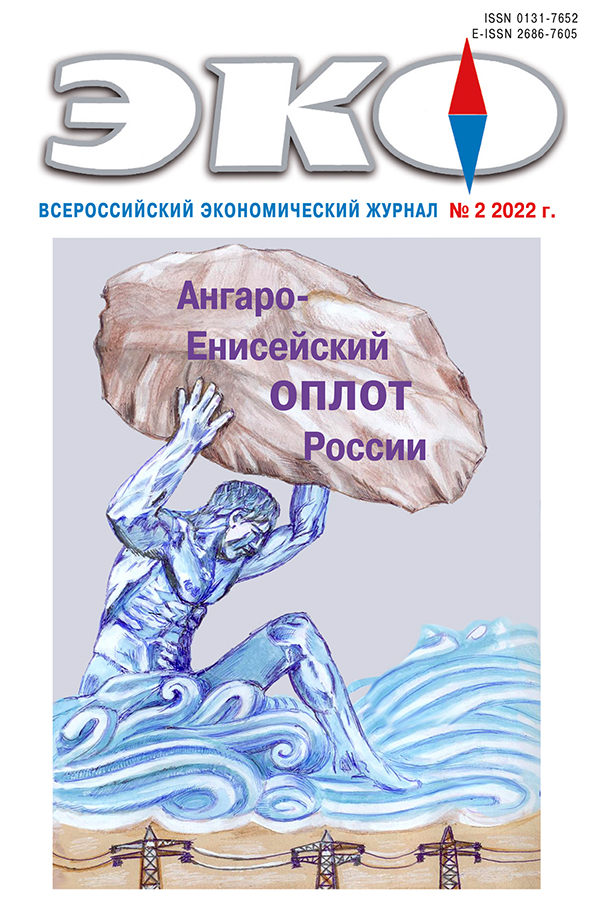PINNACLES OF ECONOMIC SCIENSE
Published 2022-02-03
Keywords
- nobel laureates in economics; natural randomized experiment; labor market; labor migrants; minimum wage; firms with high salaries
How to Cite
1.
Voronov Ю. Experimental Situations as an Object of Research in Economic Science. ECO [Internet]. 2022 Feb. 3 [cited 2025 Nov. 20];52(2):140-56. Available from: https://ecotrends.ru/index.php/eco/article/view/4386
Abstract
The paper describes the achievements of the laureates of the Alfred Nobel Memorial Prize of the Bank of Sweden in 2021. It is noted that they have done a lot to increase the reliability of economic knowledge and to increase the validity of government and economic decisions. The innovative methods proposed by the laureates for solving specific problems of labor economics and in other areas are considered. Their methods develop the principles of natural experiment, that is, the study of an experimental situation that has developed independently of the researcher. Two directions of natural experiments are also considered, in which the laureates managed to obtain the most noticeable results, in particular, to identify the actual effect of increasing the minimum wage, as well as the impact of the influx of migrant workers on the functioning of local labor markets. The results of the laureates’ research on the effectiveness of training programs, as well as the impact of the duration of training on the future incomes of graduates are presented. Innovative methods proposed by the laureates for solving specific problems of labor economy and other spheres are considered.References
- Angrist, J.D., Pischke, J.-S. (2010). The Credibility Revolution in Empirical Economics: How Better Research Design is Taking the Con out of Econometrics. Journal of Economic Perspective. Vol.24. No..2. Pp.3–30.
- Campbell.D. (1969). Reforms as experiments. American Psychologist. Vol.24. No. 4. Pp. .409–429.
- Card, D. (1990). The impact of the Mariel boatlift on the Miami labor market. Industrial and Labor Relations Review. Vol.43. No..2. Pp.245–257.
- Card, D., Krueger, A.B. (1992). Does School Quality Matter? Returns to Education and the Characteristics of Public Schools in the United States. The Journal of Political Economy. Vol.100. No.1. Pp.1–40.
- Card, D., Krueger, A.B. (1994). Minimum Wages and Employment: A Case Study of the Fast-Food Industry in New Jersey and Pennsylvania. The American Economic Review. Vol.84, No.4. Pp. 772–793
- Card, D., Krueger, A.B. (1995). Time-Series Minimum-Wage Studies: A Meta-analysis. The American Economic Review. Vol.85. No. 2. Pp .238–243
- Card, D., Di Nardo, J. (2000). Do immigrant inflows lead to native outflows? The American Economic Review, Vol.90. No.2. Pp 360–367.
- Card, D. (2001). Immigrant inflows, native outflows, and the local labor market impacts of higher immigration. Journal of Labor Economics, Vol.19. No.1. Pp.2–64
- Card, D. (2007). How Immigration Affects U. S. Cities. CReAM Discussion Paper Series. No. 0711. London. University College. Department of Economics.
- Card, D. (2009). Immigration and inequality. American Economic Review: Papers and Proceedings, Vol. 99. No.2. Pp.1–21.
- Card, D., Raphael S. (Eds.). (2013). Immigration, Poverty, and Socioeconomic Inequality. New York: Russell Sage Foundation.
- Card, D., Krueger, A.B. (2015). Myth and Measurement: The New Economics of the Minimum Wage. Twentieth-Anniversary Edition. Princeton University Press.
- Imbens, G.W., Wooldridge, J.M. (2009). Recent developments in the econometrics of program evaluation. Journal of Economic Literature. Vol.47. No.1. Pp.5–86.
- LaLonde, R. (1986). Evaluating the econometric evaluations of training programs with experimental data. The American Economic Review. Vol.76. No.4. Pp.604–620.
- Thistlewaite, D., Campbell, D. (1960). Regression-discontinuity analysis: an alternative to the ex post facto experiment. Journal of Educational Psychology. Vol.51. No.6. Pp.309–317.
- Thistlewaite, D. L., Campbell, D. T. (2017). Regression-Discontinuity Analysis: An Alternative to the Ex-Post Facto Experiment. Observational Studies. Vol.3. No.2. Pp.119–128.

